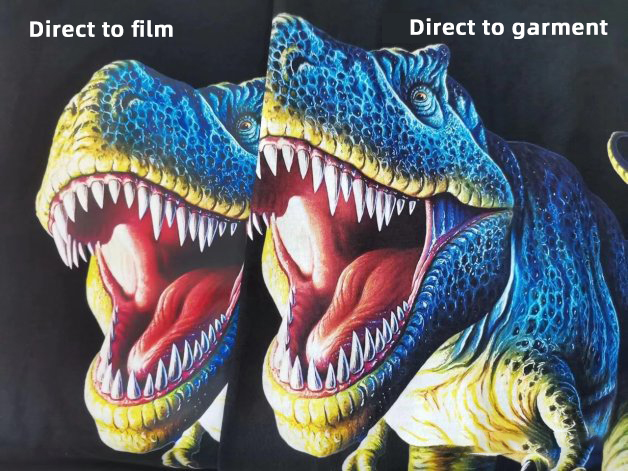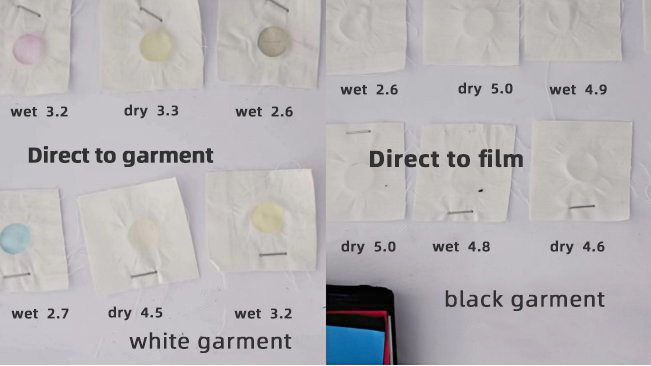In the world of custom apparel printing, there are two prominent printing techniques: direct-to-garment (DTG) printing and direct-to-film (DTF) printing. In this article, we will explore the differences between these two technologies, examining their color vibrancy, durability, applicability, cost, environmental impact, and comfort.
Color Vibrancy
Both DTG and DTF printing use digital printing processes, which provide similar levels of color richness. However, the way they apply ink to the fabric creates subtle differences in color vibrancy:
- DTG Printing: In this process, white ink is printed directly onto the fabric, followed by colored ink. The fabric may absorb some of the white ink, and the uneven surface of the fibers can make the white layer appear less vibrant. This, in turn, can make the colored layer look less vivid.
- DTF Printing: Here, colored ink is printed onto a transfer film, followed by white ink. After applying adhesive powder, the film is heat pressed onto the garment. The ink adheres to the film's smooth coating, preventing any absorption or spreading. As a result, the colors appear brighter and more vivid.
Conclusion: DTF printing generally yields more vibrant colors than DTG printing.
Durability
Garment durability can be measured in terms of dry rub fastness, wet rub fastness, and wash fastness.
- Dry Rub Fastness: Both DTG and DTF printing typically score around a 4 in dry rub fastness, with DTF slightly outperforming DTG.
- Wet Rub Fastness: DTF printing tends to achieve a wet rub fastness of 4, while DTG printing scores around 2-2.5.
- Wash Fastness: DTF printing generally scores a 4, whereas DTG printing achieves a 3-4 rating.
Conclusion: DTF printing offers superior durability compared to DTG printing.
Applicability
While both techniques are designed for use on various fabric types, they perform differently in practice:
- DTF Printing: This method is suitable for all types of fabrics.
- DTG Printing: Although DTG printing is intended for any fabric, it may not perform well on certain materials, such as pure polyester or low-cotton fabrics, especially in terms of durability.
Conclusion: DTF printing is more versatile, and compatible with a wider range of fabrics and processes.
Cost
Costs can be divided into material and production expenses:
- Material Costs: DTF printing requires lower-priced inks, as they are printed onto a transfer film. DTG printing, on the other hand, requires more expensive inks and pretreatment materials.
- Production Costs: Production efficiency impacts cost, and the complexity of each technique affects efficiency. DTF printing involves fewer steps than DTG printing, which translates to lower labor costs and a more streamlined process.
Conclusion: DTF printing is generally more cost-effective than DTG printing, both in terms of material and production costs.
Environmental Impact
Both DTG and DTF printing processes are environmentally friendly, producing minimal waste and utilizing non-toxic inks.
- DTG Printing: This method generates virtually very little waste and uses non-toxic inks.
- DTF Printing: DTF printing produces waste film, but it can be recycled and reused. Additionally, little waste ink is generated during the process.
Conclusion: Both DTG and DTF printing have a minimal environmental impact.
Comfort
While comfort is subjective, the breathability of a garment can influence its overall comfort level:
- DTG Printing: DTG-printed garments are breathable, as the ink penetrates the fabric fibers. This allows for better airflow and, consequently, increased comfort during warmer months.
- DTF Printing: DTF-printed garments, in contrast, are less breathable due to the heat-pressed film layer on the fabric's surface. This may make the garment feel less comfortable in hot weather.
Conclusion: DTG printing offers superior breathability and comfort compared to DTF printing.
Final Verdict: Choosing Between Direct to Garment and Direct-to-Film Printing
Both direct-to-garment (DTG) and direct-to-film (DTF) printing have their unique advantages and disadvantages. To make the best decision for your custom apparel needs, consider the following factors:
- Color Vibrancy: If you prioritize vivid, bright colors, DTF printing is the better choice.
- Durability: If durability is essential, DTF printing offers better resistance to rubbing and washing.
- Applicability: For versatility in fabric options, DTF printing is the more adaptable technique.
- Cost: If budget is a significant concern, DTF printing is generally more cost-effective.
- Environmental Impact: Both methods are eco-friendly, so you can confidently choose either without compromising sustainability.
- Comfort: If breathability and comfort are priorities, DTG printing is the better option.
Ultimately, the choice between direct to garment and direct to film printing will depend on your unique priorities and the desired outcome for your custom apparel project.
Post time: Mar-27-2023


